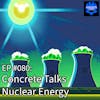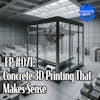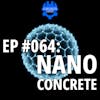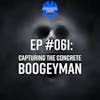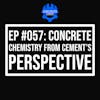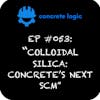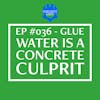EP #041 - Typical Concrete Vapor Barrier Detail Defies Science

Are we detailing the placement of vapor barrier in the typical slab-on-ground design all wrong? When moisture develops on a concrete surface, where is it coming from? Below the surface or above? Bob Higgins, a concrete and waterproofing expert, joins the podcast to help us answer these questions. We discuss extensively the science of how water vapor is created and why today's concrete must be internally cured to perform its best. If you want to learn about another controversial topic in the concrete industry, you'll enjoy this podcast. Listen to see if we can blow a hole through the ACI 302 standard! Episode References Guest: Robert (Bob) Higgins | RC Consulting | rcconsulting.higgins@gmail.com Guest Website: https://www.linkedin.com/in/robert-higgins-b8294411/ Music: Mike Dunton | https://www.mikeduntonmusic.com | mikeduntonmusic@gmail.com | Instagram @Mike_Dunton Host: Seth Tandett, seth@concretelogicpodcast.com Host website: concretelogicpodcast.com
Seth: [00:00:00] And welcome to another episode of the Concrete Logic Podcast, and today I have Robert Higgins with me. Robert, could you introduce yourself?
Robert Higgins: Oh, yeah I've been involved with concrete Waterproofing since 1976. And then in 1985, inadvertently I started also doing some con construction defect litigation, which really was eye opening.
And I was, I started a company. With my brother back in 1979 where we created waterproofing products and we grew to have a global presence. But I found that as we grew, it became more of a marketing situation and I lost my zeal port because I loved the research. I loved going out and troubleshooting and problem solving.
So I broke off in 2009 and became an independent consultant. I've an independent consultant ever since. [00:01:00] And I've really enjoyed this. It's given me a it's nice too because I don't have to watch what I say.
Seth: Yeah, that is nice. Yeah. So yeah, you're and the way we connected is as a lot of my podcast guests are you're very active on LinkedIn and there was a post that a fellow Josh Bong he's a concrete guy out in Oregon, and he posted a picture of his work and always appreciate Josh's work.
He does fantastic work. And he had a post, he was putting a slab in and I saw something curious. The vapor barrier. Which I'm accustomed to seeing I'm accustomed to seeing the vapor barrier. Set on top of the base for the slab, and then the concrete's put directly on top of the vapor barrier.
And Josh had vapor barrier. And then it looked like he had a layer of sand. And then he was put, he was gonna put concrete on top of that. And I was like, Josh, what is that? Why [00:02:00] is the vapor bear below that? And he's that's what they specify out here. And then you chimed in and you said, Hey, this is something we need to talk about some more.
And you put it out there and I, and I guess I took the bait and said, come on Robert, let's talk about it.
Robert Higgins: Yeah, I disagree with the sand bed because that encourages popularity. But if you use a larger graded stone, it's a great capillary brick, and it, what it does is allows the top portion of the concrete and the bottom portion of the concrete to become their own gradients.
And why I don't like a vapor very directly below concrete slab is it won't dry. Yeah. Now what will happen when it doesn't dry and the surface dries? Too quickly. You get curling and map cracking and that's become almost epidemic and it's gotten worse, steadily worse since right around.
And then then about at two, right? At the, of 2018, [00:03:00] going into 2019, it's become a national issue because cement now is more alkaline than it used to be. Yeah. The concrete that you're placing now is not the same as it was prior to 2002. Yeah.
Seth: Yeah. I don't mean to interrupt you, Robert, but what we wanna do, I think first, let's explain what a vapor barrier is and what it's intended use is for, because we wanna make sure everybody listening understands what we're talking about first. So could you explain what a vapor barrier is and maybe the origin of using a vapor barrier.
Robert Higgins: This will be a little controversial. The origin of a vapor barrier was based quite a bit on a study that was done by the Portland Cement Association back in 1965. That's called a lot of people refer to as a brewer study. Now, the brewer study was entitled in slab on ground [00:04:00] and moisture.
So everyone assumed by. Headline reading that moisture underneath the slab was a problem and they needed to put a vapor barrier underneath to stop intrusion of the moisture. Cause the moisture would eventually work its way through the concrete, get to the surface and cause a flooring issue. I reviewed that a couple years ago and I was appalled cuz I never actually sat down and read it.
That is not what the study says at all. It says that the moisture coming off the surface of the concrete is what causes the problem, which agrees with all the other studies I've seen recently. It was a misconstrued concept that moisture comes from underneath. Through to the surface. Now I've had people say of course it does.
No it doesn't. That is a fallacy. It's a false precept that's just persisted and we need to undo this. Because if you really think about it I like what Dr. Joe said over at building sciences symposium just last [00:05:00] month where he said that, moisture and liquid in a vapor form moves from warm to cool.
That's the mechanism. So I asked him, so what about the mechanism if it's warmer on the surface? He said it doesn't transport them. I said, ok. So he said The room is typically warmer and average is warmer than the concrete surface. The concrete surface typically is warmer than the concrete underside.
So the movement of moisture is down, it's not up, it's down. So what they're doing is they're confusing diffusion with moisture migration. Which I'm not gonna get into just right now cause I wanna get back to the vapor barrier. So the vapor barrier as far as I'm concerned, keeps contaminants from the soil getting into the concrete.
Cause there's a lot of stuff in the soil. You don't want to get into your concrete. And by diffusion it will trans, it will transmit through the concrete. So we have to be careful with that, do like it for that point. But[00:06:00] as. As a method of keeping moisture outta the concrete. I don't I could care less.
It's, that's not what it's really functioning. That's not what it actual function is. It's actual functions to keep garbage in the soil, getting into the concrete.
Seth: Gotcha. Yeah, cuz that's I was like I shared with you before we hit record, I was brushing back up on my ACI 302 Guide to Concrete Floor and Slab construction.
And they as long as I'm reading the most up-to-date one, but their recommendation is the vapor barrier directly underneath the concrete. And again they're saying that it keeps they're saying the moisture is coming up from underneath. I guess is what their belief is their study research is, and what you're saying is you're saying it's coming from above and through the concrete.
So yeah let's discuss this [00:07:00] more because this is what we were looking at that picture that we saw on LinkedIn from Josh. It's It, I guess that was like, that's standard practice on the west coast cuz it seemed to be very popular. I was watching a video of a guy in California, another consultant, and I guess there was a practice of putting a sand layer.
Above the vapor barrier as well. And they were saying that helps draw the moisture out the concretes of the concrete cures quicker versus if you put it directly on the vapor barrier.
Robert Higgins: Yeah. And again, that's another false precept because drawing, drawing concrete doesn't make it cure quicker.
It just makes it hard and quicker. It you to cure concrete wouldn't keep it wet. Now if you want it to be a capillary break, which was the original reason for putting that in there you need a larger stone because the tighter your pore space, the more capillary you get. That's just how it functions.
That's why you can get capillary movement. You get what's called rising damp. [00:08:00] And if you look at rising damp and some of the historical buildings where they're dealing with that. It's almost always on the cool side. You rarely ever see problematic rising damp on the warm side of a building.
That's because water moves from warm to cool. If the top surface of the concrete is warmer than the underside, what is the mechanism of movement? I can't get any of them to gimme a straight answer. They dance around. The reason why you can't gimme a straight answer is because that violates the laws of thermal dynamics.
What you're confusing is diffusion how diffusion works with concrete and everything else, and this is what we learned in high school. If you have two containers and you're, and it's connected with a valve, you've got the valve closed. The one side has dye in it, the other side doesn't. You open the valve and what happens?
The dye moves and eventually evens out. That's called the fusion. The water didn't go anywhere. It doesn't have to, it's like a freeway. [00:09:00] It allows things. That's what's, that's what's moving everything itself. And they even and what I, what found the most profound one to me before I get into some of the more modern ones.
There was a 1974 study done by the Army Corps Engineers. It was for concrete. They're going to use nuclear facilities, so they're exposed the concrete to 150 degrees above. I think upwards 160. And what happened as they kept trying to dry out, all of a sudden would hit the front and the water in the center of the concrete would not move or maintain a constant moisture content throughout the duration of the test.
They were a little confused by that. If they understood the chemistry of what's going on in there, there's nothing confusing about that one. Water doesn't wanna move to the. And then what happens with the alkalinity as alkalinity begins to concentrate as you dry it out, [00:10:00] alkalinity has a reciprocal reduction of humidity.
So when the humidity is reduced, it means it re, it resists evaporation. And if you keep concentrating it, you can get to a certain point where if you concentrate the alkalinity enough, and this one is a shocker to most people, and the researchers, most of them don't know this. But the sodium hydroxide the main alkaline component and concrete, it can actually raise the freezing point of water up above a hundred degrees Fahrenheit so the water doesn't behave like liquid water anymore.
It's starting to behave like it's freezing. Huh. And I tell people, so if you want to and I really suggested is go look at what they do with sodium hydroxide for bulk storage and shipping. They have to keep the lines and the containers heated because if they don't, at the 40% concentration, they have the freeze point of that water is a 59 degrees Fahrenheit.
But it, [00:11:00] but certain hydroxides weird because at a lower concentration at 20%, it will drop the freeze point of water to 13 below zero. And I go, in fact, if you look at the graph, it looks like a drunken mosquito, but as it concentrates past 40%, it. 10. There is a, there's a downward trend at one point, but then it goes back up.
You can actually, if you concentrate it to about 80%, the freeze point of water can approach that. What would normally be boiling point. So we're not dealing with water in the same form that we've assumed, and everybody's ignored that, and they're wondering why the concrete won't dry out. It won't dry out because it doesn't want to.
You've hit an impasse. Cause the other thing is the sodium hydroxide will begin to grab moisture from air at humidity at less than 10%, even down to 8% relative humidity. [00:12:00] Sodium hydroxide will pull moisture from the air. So even if you're using desiccators, the desiccant isn't as effective as the sodium hydroxide is.
The desiccant inside the concrete is more effective than the desiccant you're trying to use to pull the moisture out. So it's these informational gaps that are leading us to all these speculative. How about if we try this? Let's do relative humidity as a test. That's one of the dumbest tests I've ever seen.
You can't measure moisture concrete with a relative humidity probe. It doesn't do it. What a humidity probe does is it measures what's supposed to be the balance of water vapor in the pores of the concrete. That's supposed to be an equilibrium with the liquid water and the concrete, and it's fun in a lab condition because the temperature is the same all the way around the concrete.
The relative humidity is the same. It is not that way in a field. It bounces all over the place. And when it bounces all over the place the response to heating and cooling and wetting and drying begins to change. [00:13:00] And they've actually and in the last 20 years they started researching this and they've referred to this as concrete hysteresis where water will be absorbed, but it doesn't what they call ingress and doesn't egress at the same rate.
So they're one in light. It's not doing that well. If they look at the chemistry, it makes perfect sense, but they're not looking at the chemistry.
Robert Higgins: [00:00:00] The alkalinity and concrete has always been an issue and it's not been recognized and fully appreciated. In fact, in studies I gave a seminar little over 20 years ago.
At the Florida State University and the engineering department was there, and there's some people from the Department of Transportation, and I told 'em that basically most of the studies done in concrete in the last 70 years are done incorrectly. And they stopped me and they said, how can you make such a broad statement like that?
I said if you look at all the studies, everyone I've read, they just talk about the hydroxyl and they put up this big, nice deep pile, and then you push it off to the side. I said the problem is the primary alkaline, the primary alkaline material that spun off as cement develops is calcium hydroxide.
They call Portland Diet. That doesn't react the same way to temperature that sodium hydroxide does. Sodium hydroxide gets more active as it gets warmer [00:01:00] and calcium hydroxide goes the other way and it gets more active as it gets colder, and it's actually most active when it's just right above freezing.
Most of the researchers don't even know that. Why they don't know. That is really disturbing to me. They're supposed to be telling us what to do with their concrete. They don't even know what the hell they're testing. I'm sorry, but they don't, it's drives me crazy. But now, fast forward to go to 1997.
This report came out by VTT. Talking about the where they were, they started using more sophisticated methods, testing the relative humidity, as well as using.
And it, it's been established by the Portland Cement Association and all these researchers prior to that powers, and there's all these other names I can't think of off the top of my head, but it shows that when concrete is cured in warmer temperatures, it ends up having[00:02:00] durability issues down the line.
The warmer the concrete is placed at the time of cure the weaker it becomes, the less durable it's, and that's been consistent for decades. What they found was, and was shocking to me, and I didn't know this and I don't think anybody else did, but when they put those thermocouples in there and they put the humidity devices in there, they had one that was embedded and they had some from the surface so they could look at it from two different views.
Shockingly, the relative humidity at the surface of the concrete dropped to between 50 and 60%. The reason why that's so bad is cement will not form if the relative humidity drops below 80%. So for the first two, three weeks, you're not getting any cement development in the top inch of the concrete or very little.
Now, as the temperature increases, that gets worse and it's a longer duration, and you have what's called a cascading effect, where one. [00:03:00] Influences the other because as the concrete gets more alkaline as it dries out like that, the alkalinity by the sodium hydroxide now imparts a hydrophobic response or basically makes calcium hydroxide insoluble.
So even if you put water on it, when you're carrying it for seven days or so, it doesn't make much difference. It will still not develop all the cement.
Then in thousand six, Dr. Dollinger from the Texas Transportation Institute ran this test because he noticed there was a gradient portion of the concrete, the top inch of the concrete was having issues. So he did one where he didn't water cure and did water cure for seven days under laboratory conditions and the seven day water, when you sliced the top inch off, it was a full 20% weaker and compressive value than the remainder of the concrete.[00:04:00]
So all and then over in Portugal, over in the Middle East, over in Asia, they're finding the same thing over and over again. So now with the more alkaline cement that we're getting by adding the cement killing dust, we now need to move towards, Internal curing of concrete circus curing will not get it done, period.
If cur, they're blue in the face, it won't get it done.
Seth: And where's the alkaline coming from?
Robert Higgins: The alkaline is coming from the cement. Now the thing is, the Ready-mix producers are being victimized by this because they're supposed to. Devolves whatever, add ad mixtures or anything else that's extra in the concrete.
But since this is added at the time of the cement production, they have no knowledge of this. They don't know what's in it or how much there is in there. So they're probably seeing problems and they're just going, maybe we're doing something wrong and they don't wanna talk about it. These are things beyond their control and if they're made aware of this information, they can make corrections [00:05:00] because you can internally tear concrete.
Now, one of the things that really cracks me up is expanded clay shell and. And whatever else it is where they make the, all these lightweight aggregates and they were shamed back in the day saying you can't use those aggregates cause they contain water and it makes the moisture problems worse.
Actually. They're found finding now that when you put this abortive aggregate and the concrete, it helps internally cure it. You end up giving you a better piece of concrete. Huh? They inadvertently headed in the right direction. But it's not distributed well enough. So there needs to be other factors involved where you start adding materials to the concrete that don't interfere with water cement ratio, but act as a water reservoir to help cure the concrete.
What are the technology's there? It's just not. Yeah.
Seth: Yeah. But what are they doing during, what are they doing during this cement manufacturing process to get the alkaline in it? What's changed [00:06:00] over the last 20 years that's causing that?
Robert Higgins: That's been required by the EPA. The EPA said, you gotta recycle this stuff. A lot of it goes into waste and they're trying to figure out other uses for it, but a certain percentage of it is reintroduced back into the cement process. So the, so all the cement we have now is more alkaline now.
It was really funny as the concrete and cement, cement industries came out with a kind of a tepid announcement that no more low alkali cement will be offered. The reason why it's not offered is cuz you can't make it anymore. It's cause of CKD, the cement kiln dust doesn't allow for low alkaline cement.
You can't make it anymore.
Seth: So the EPA is requiring them to use the CKD?
Robert Higgins: Yes. That's the requirement. So that was taken outta, they thought it, the first big fight was back in 1990. So they were [00:07:00] able to delay it for another 12 years. Cause the one concrete company said, look, our almost entire business is based on low alkaline cement.
We have to start making changes before this is enacted. So they gave them time to make the changes they needed to make.
Do you know what the purpose of. Yeah. What was the purpose of the EPA requiring that?
It's because of the flu gases. Cause this came out in the flu gases and was polluting the air and was the carbon footprint and all that stuff.
It's all environmentally. Safer by re recapturing the flu gases, and part of the flu gases, cement, kiln dust. Oh,
Seth: okay. So it's, they're capturing it and it's falling back into the processing is that They're actually adding it back in. Oh, they're actually adding it
Robert Higgins: back in? Yeah, they're actually specifically purposefully adding it back in.
Seth: Okay. So they're capturing it and [00:08:00] reusing it. And that satisfies what the EPA
Robert Higgins: requires. Yeah. And it doesn't affect the 28 day required compressive value of 3000, 4,000, whatever they're aiming for. But it does hurt the concrete for long term durability. That's why we're seeing concrete now.
Even if you're placed exactly the same way you did 20 years ago, it's not as durable. You're seeing problems with it early on when you get washout and everything else and you're getting early ASR a lot of surface ASR is occurring. They call near surface alkaline aggregate reaction, and that's all because of the alkaline.
The higher alkalinity. It's higher alkalinity, which triggers the damage.
Seth: Yeah. Remind our listeners what ASR
Robert Higgins: is. It's alkaline silica reaction. Basically that's when the alkalinity in the concrete starts dissolving some of the softer aggregate and usually the smaller and amorphous aggregate goes first, and that's all the [00:09:00] stuff that floats to the top.
So as you keep, as you see, when you get d cracking ASR and all this other stuff on your concrete pavements, it's triggered by this and we now, the trigger is much higher. So this triggers harder, faster, and earlier. They used to, so we have to compensate for it, or we're gonna just be in a world of hurt.
Cause we're gonna they're already placing concrete that needs to be repaired in as little as 12 years on roads and bridges. That's ridiculous. That was not like that in the past. Yeah. But if we internally cure it, that will keep the alkaline from concentrating. It doesn't move. Cause when you internally cure concrete, what you do is you've eliminated a lot of the freeways that would normally have, you're reducing the capillaries in both size and connectivity and it keeps the upline from increasing because they're all scattered.
They can't gather and concentrate.[00:10:00]
Seth: Gotcha. I didn't catch that last part. How do you separate 'em again?
Robert Higgins: By internally curing the concrete. The only way we're gonna be able to fix this. So that's my biggest emphasis.
Seth: And yeah, and the internal curing. And that's introducing what into the concrete to, to have it internally cured.
Robert Higgins: What is. My two favorite materials. But they have to be engineered correctly because if you do it wrong, it, you can cause uneven stress that's in the concrete. So that needs additional research and they have to verify what they're doing. Don't use something that hasn't been verified because there's a lot of Say just overly enthusiastic people selling something they don't quite understand.
Yeah. But I like the combination of abortive aggregate, cuz you can actually have normal weight aggregate, but still absorptive. And I think it's a great idea along with what's called a colloidal silica. [00:11:00] Silica has to engineered to where it doesn't react too or.
Not behave in the manner that you really want to. I don't wanna go into that. Cause people will borrow off that and you just have to help sell their products. So I'd rather not share that.
Seth: Yeah. We've had we've had some colloidal silica internal cure folks on the on previous. So when you say aggregate that absorbs what kind of aggregate is that the clays you mentioned before
Robert Higgins: or?
Yeah. And also there, there's other types that you know, that are limestone based. There's other ones that are, semipermeable and those all really help. They don't hurt the water cement ratio because the water is essentially, cause it, if you soak the aggregate and let air dry and then you add to the concrete, you're not adding to the water cement ratio.
But what you're doing is you're adding reserve. Cuz what happens as the cement formation occurs, it absorbs water from the mix. [00:12:00] Unless you have something to replace it, the concrete against the dry out. So if you have an aggregate where there's a moisture reserve, it will pull to that area and keeps replacing the moisture to get a more complete reaction to the cement and it helps cool it. Now internal cooling, as called the evaporative cooling effect, which has not been studied by these researchers and really irritates me.
That is one of the most effective ways of getting concrete to really get dense all the way through where we get a more uniform, more homogenous mix. And the small, so the smaller the particles, the more surface area you have, so the more evaporative cooling effect you get.
Seth: So the aggregate acts as a, like you were saying, a reservoir and then it, when the cement needs it, it pulls it from there.
Yes.
Robert Higgins: Yeah, it's got reserved. So instead of it drying out, cuz unfortunately the pozzolans they put in, they're dry add pozzolans, they actually start competing. So [00:13:00] what will happen is they actually make the concrete worse if you don't get complete hydration cause they're dependent upon the initial cement formation to produce anything beneficial.
So the pozzolans are actually making the concrete worse when in the past seem even better. So it's, we're really upside down in all this. We need to reboot.
Seth: Yeah, it sounds like it.
Robert Higgins: See, and here's some moisture testing. That's why it's so convoluted as well. It's the top one inch surface of the concrete is where all the problems are occurring.
When they do our inch probe test drill in two inches, they completely bypass the problem air. Oh, look, it's great. It's not, yeah.
Seth: One, one little test and how many square feet?
Robert Higgins: Yeah, and that kind of doesn't matter. So that's why I like I like a concrete meter cuz it, it'll measure. The surface moisture measures in about three quarters of an inch.
Cause that's really where the problem is. And I don't wanna be proprietary, but one pro, [00:14:00] one company did do that. And what and it was tested in Finland where they u weigh it against gravimetric.. Gravimetric is the most accurate way to test moisture and practically anything. Cause they put it in oven they dry it out and they all the free water's removed.
And that one product it was brought out in the field because there were some other products that agreed fairly well with the gravimetric in a laboratory setting. But boy, when you took in the field, they started, the results started going all over the place, and only the one product kept in alignment with, on Gravimetric.
So that's what I'm telling people. I said, do not base anything on a laboratory study. They bring it out in the field first. Then you, what you do is you bring in laboratory to evaluate what you're looking at, and then you can look at the mechanisms. Everything I've ever seen that's first developed in a laboratory, you end up screwing up and it's, the customer is the Guinea pig.
The person who develops it should be the Guinea [00:15:00] pig, not the other way around, where it's the tail wagging the dog right now. Yeah. And if we bring this back to fundamentals the flooring industry over the past year by some of the flooring manufacturers said that the claims have now hit 3 billion a year, years ago, was 1 billion a year.
It's accelerating. It's, I expect it to triple again unless they do something dramatic and change what they're doing.
Seth: Yeah, you would think the insurance comp insurance companies would be jumping in and pushing this.
Robert Higgins: They should, but it's a matter of getting to the That's a great idea. Cause if the insurance company knows there's a way to fix this, they could put some pressure on it.
But I am working now with ISE. And working with some other groups where they are recognizing the need to start changing things because when these international studies all agree with each other and they don't even know of each other that's pretty compelling when they keep getting very similar results.[00:16:00]
Yeah. There's a consistency and problem and all the moisture problems, again, follow the laws of thermal dynamics goes from warm to cool, but so it's soaking into the surface. And one of the ones I'd love to use, and please feel free to use this as well as a demonstration to your clients and anybody else you talk to.
There have been some NBA games and even college and high school games all through the country that had to be canceled because what the, what will happen, it's like this one thing with September wolves versus the Knicks or something like that, or 76ers. They forgot to turn on the HVAC system, so people were coming in and the air was too warm and with all the people breathing, the cold surface started getting wet.
So they kept mopping it, putting fans on it. They take the fans off and get wet again. They keep doing it, so they finally had to cancel the game. That moisture was coming from the air. 100%. Yeah. If that was a bare concrete surface and you were working on a job site, [00:17:00] you would've never even seen that. All that water was soaked into the concrete, and if you'd run, if you'd run tests prior to that and then subjected to all those environmental changes, by the time you put in a floor, it'll fail.
That's where almost a hundred percent of the failures are coming from. Huh? Completely avoidable.
Seth: Yeah. So let's circle back around to the vapor barrier where we started this conversation. So what should we be doing and differently than what we're doing right now and what ACI 302 is telling us?
Robert Higgins: Yeah, I would put a graded large to medium aggregate underneath the I would put the vapor barrier down and put the large aggregate over there. Graded. Aggregate, make sure it's self compacting. I don't like sand cause it won't compact. It's gotta be a graded aggregate that acts as a capillary break.
It gets the water somewhere to go cuz the water from underneath is not gonna magically make its way to the surface. That false precept. I've never seen any compelling [00:18:00] information that has convinced me that they can go against the laws of thermal dynamics and the moisture magic that goes through.
They're confusing moisture migration with diffusion.
Seth: Because we're saying the warm Yeah, the, yeah. Cuz the warm air is going to where it's cooler and that's where the water is concentrating. That's what we're seeing physically, visually seeing is the water beading up on the concrete and we're thinking it's coming from within.
But what you're saying is it's the warm air. Coming down to the concrete. That's cuz that's where the cooler temperature is.
Robert Higgins: Correct. And that's why propane heaters are such a bad idea. Cause propane the, if you're trying to warm up a room, that's a really good way to feed the concrete, a lot of water.
Cause the main exhaust of propane is water. It's, 10 units of consumption of propane nines are converted to moisture. You don't wanna do that now. I [00:19:00] was in this high tech facility. I'll give a couple examples. We went in there and the floor had failed and they, inspector they'd hired said it needs to be moisture. They need to put in moisture mitigation cuz the moisture's too high.
I looked at the concrete mix design back then, and I said, there's no way it can be that high. I said that's gotta be a ambient moisture condition or something came in from the top. And he said no. Everybody knows the moisture comes up from underneath. I said, not with a 0.45 water cement ratio.
No, it's not gonna happen. I said and then what I did is I brought in a device with me. I had a digital hygrometer. And an infrared thermometer. And I took a took a shot of the temperature of the concrete as well as the air. I looked at the digital hygrometer while we were talking.
We were in the small room and there's a bunch of us in the room. I said, okay, the 15 to 20 minutes we've been in here, the relative humidity in the room climbed from 52.[00:20:00]
Moisture condition that the concrete's gonna be drawing moisture into it. Cause we're within 10 degrees of Dew Point. If you're within 10 degrees of Dew point, you can almost guarantee you're gonna have an issue. So I said I said I, I know what happened then. So let's duplicate what they did, but this time we're gonna monitor the room.
So we monitor the room, we have them spread the adhesive, the relative humidity in the room climbed over 90%. It was like a sign in there, even though it was fairly cool. And of course the floor field, just like I predicted it would said, cuz you're adding water back into the concrete.
So we dried out the concrete. Cause it, it was a water-based adhesive, a stuck the digital hygrometer underneath the lid. And it jumped up almost to a hundred percent right away. I said cause there's water in this adhesive. I said, yeah, it's 10% water. I said, there we go. There's our water source. So what we had them do is dry the concrete back out.
We measured the concrete, made sure it was it was under 5%. Under [00:21:00] 5% moisture. Then we brought in dehumidifiers as well as air movers put the air movers across the concrete, and that's what helped dry it out. Because that's the other thing, when you're trying to dry out concrete, you need to move air.
Especially across the surface, the coolest portion of the evaporation process is right at point evaporation. That's why sweating cools us off. Now if you separate it, you put it out here, you won't cool off. So what you wanna do is you wanna remove it. So by blowing air across it, you remove the evaporative cool effect.
It makes the evaporation more efficient, so you remove more water much quicker. So we brought in the dehumidifier. We kept the dehumidifier between 55 and 60%, installed the exact same floor. It was so well bonded. They couldn't pull it off the floor. They couldn't get it off the concrete. Yeah. And they didn't need any moisture mitigation, but the default is to moisture mitigate because, gee, it must be coming from the concrete.
No, almost all of it is [00:22:00] coming from the air.
Seth: Is that air, that's air that's blowing through the HVAC? It was in that case, or where, or just ambient.
Robert Higgins: This moisture was actually coming from the adhesive itself. The adhesive was providing this own moisture problem. Oh yeah. Warm surface sucked in. Yeah.
Seth: So yeah we talked about the adhesive water problem on another podcast. That's why I chuckled.
Robert Higgins: And why does it do that? Because the concrete's cold or the concrete's warmer, it wouldn't soak up. So what
Seth: I guess just something jumped in my head. So the concrete being cooler is the problem.
What are your thoughts on the heated floors like running the heated tubes through the floor and using that as your main source for heat in a room. versus blowing, the American way, which is blowing hot air through the house or through the building and everything like that.
Using that. And then having, you were [00:23:00] saying what's good is also circulating the air, so having ceiling fans or something of that nature, moving air through there, is that a better approach to. To help solve this problem or,
Robert Higgins: yeah, I think so. Yeah.
Cause, cause what if.
Where the relative humidity in the in the air is below 60% and you've got the temperature, the concrete close to the air you're not gonna have an issue because one of the things I keep hearing is these moisture sensitive adhesives. That's a bunch of hogwash. What I've done is I've take these moisture sensitive adhesives I've laid up on cement board as long as properly.
They're very water resistant. I stuck the same ones into a bucket and left them for a year. Not a darn thing happened. Yeah, not a thing. So what happens if you put it down though and there's moisture in there? That moisture is gonna prevent a good bond and it's gonna prevent it from actually [00:24:00] setting and curing properly in the first place.
That's what causes your blisters and epoxies. Cause you have too much moisture in there. Yeah.
Seth: Huh That so the vapor barrier obviously, or what we're saying today is we're putting it down for a reason that it not, might not necessarily be helping with that reason. So it. Here's a crazy question.
What's the point of putting the vapor barrier down? Is it just the block like radon or whatever coming out of the, out the ground or,
Robert Higgins: yeah. If you got radon or you got contaminants, but if you put a good capillary brake, you don't have to worry about the contaminants cause there's no pathway for the moisture to move through.
So what would that
Seth: be instead of a vapor barrier? Would it be a capillary brake?
Robert Higgins: Good crush. Rock. You like GT?
Seth: No, that's what I'm not trying to put Stego outta business. I'm just asking questions.
Robert Higgins: Stego [00:25:00] is great for keeping if you're in an area that used to be farmland or they used to grow crops, absolutely use vapor barrier.
And if you're in an area where you're close to where there's a dump site or there were a lot of plants and you don't know what's in the soil, I would use a vapor barrier. Not for keeping the moisture out, but for keeping garbage that's in the soil that shouldn't ever be in concrete. Cause that will transmit very quickly.
Cause that's where your diffusion comes in. When there's something that's water soluble and enter enters into concrete and it's now invasive, it goes from higher to cool to lower. So what it does, it starts working its way through that can its way.
Yeah, in fact, there got some efflorescence at these at this place over in El Centro, in just outside of San Diego, and they couldn't keep the epoxy floor down. So look at all the alkaline efflorescence . I said, don't always assume it's alkaline. It says, especially since this used to be crop, [00:26:00] they used to grow crops, orange trees, and everything else out here.
So sure enough, I did a test on the, so alkaline efflorescence .
So it was actually destroying the concrete itself. The concrete's talked and marked and weakened and that stuff worked its way through. The concrete was 30 year old concrete, but it's now starting to break down. Yeah. Cause it so contaminated,
Seth: huh? All right, so we're saying use the vapor barrier, but.
Maybe not the way we've been using it before and not, yeah. Put it,
Robert Higgins: put, yeah. Put the capital brick back down on top of it and put it where it's supposed to. Yeah. It should be.
Seth: And then that will put in the vapor barrier below the crushed stone layer or granular layer that would help with the other issues we're having that we're seeing in concrete
Robert Higgins: with. Yeah. And if you look from two, from year 2000 earlier, [00:27:00] ACI required a capillary break on top of the vapor barrier.
They required it that he would get in trouble if he didn't do it that way, and all of a sudden he reversed and they reversed on a false preset. What year was that? Prior to 2000 year. 2000 earlier. I think it may have been even as late as 2002. But prior to that, they required a capillary break over the vapor barrier.
Huh? It gets really interesting, doesn't it? When you
Seth: start looking at history? It does. I was enjoying the it's been a while since I looked at ACI 302, but I did like their chart where they explained when to use a vapor barrier, when not to use, how to use it. But it seems like there's language in here that says, basically it's saying that this is very controversial, is what it says in ACI 302.
There's still discussions being [00:28:00] made.
Robert Higgins: The reason why is cuz it violates the laws of thermodynamics. How the moisture supposedly magically makes its way from cool to warm.
Seth: Yeah. So if you were consulting on What's been popular lately with the warehouses and the distribution centers?
You, you wouldn't, you would have a you would have them put the vapor barrier below the base. Correct. And then, okay. Correct.
Robert Higgins: Huh? Because if they said what about the water that can get in the crushed rock? So Concrete loves to stay wet. You keep it wet. It's if you look at some of these tunnels were built back in the fifties and sixties, that concrete, that was originally 2,500 psi, it's up around 8,000 PSI now because it's maintain wet condition, concrete to be wet, let stick wet, just don't allow the water to move.
Yeah, it's really that the simplicity of this is to let's get in the condition that wants to be in and let's get it in the [00:29:00] conditions where it'll tolerate something that doesn't like water. Yeah,
Seth: no, I think that's yeah. This was a great discussion today Robert, but I think there's a good spot to pause for today.
We'll have to, we'll have to pick it up again. Are you are you. Are you participating in anything that is doing studies on this or? Yes. You are? Okay. Yes. And is it ACI driven or is it from someone on? No.
Robert Higgins: Real happy.
Seth: Yeah. Okay. So if folks that are listening to this, they wanna reach out to you and learn more or support you and what you're doing, what's the best way to get ahold of you?
Robert Higgins: Probably my email. Rcconsultinghiggins@ gmail.com.
Seth: Okay. Yeah, I'll put that in the show notes. So when we put this out, people can get ahold of you and he's also Robert's active on LinkedIn, like I said. So g give him a shout on there. Reach out to him, connect with [00:30:00] him. And yeah, this is, this was as, as nerdy as it sounds.
This was pan, this was great stuff. I didn't think we could talk almost an hour
on vapor barrier.
Robert Higgins: You're talking to fellow, geek, I.
Seth: All right, Robert. Thank you. And we'll have we'll have to do this again.
Robert Higgins: Okay. Sounds great.

Robert Higgins
Involved with waterproofing and restoration of buildings and specialized in concrete. Have been involved with several committees with professional groups such as ICRI (first chair for moisture testing), CSI, speaking at national and regional conferences, authored the Flooring industry “White Paper” for the WFCA (World Floor Covering Association), moisture test instructor for the Academy of Textiles and Flooring, guest instructor for ICRI. Authored many articles regarding weather and environmental durability of concrete in multiple publications. Currently involved with IICRC Committee S230 and NFCA (National Floor Covering Association) “best practices” for moisture testing concrete prior to installation of Floor Materials.









